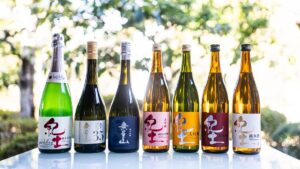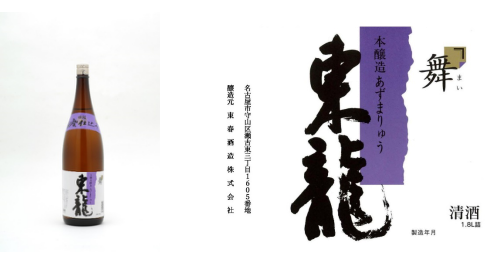
“Azumaryu”is brewed in Nagoya-city, Aichi Prefecture.
Contents
How the name of“Azuma-ryu” was Born
“Azuma(東)” in “Azuma-ryu” represents “east” and it also reads as “Toh” in Japanese. “Ryu(龍)” represents “dragon” and it also reads as “Tatsu”.
The founder of the Toshun Sake Brewery was Tohbei Sato, and the original name of brewery was “Tatsu-ta-ya”. So, “Toh (東)” from founder’s name and “Tatsu(龍)” from brewery’s name were given to their sake. The relation of “east” and “dragon” originates in the "dragon" of Seiryu, the guardian deity of the "east" *1.And they adopted Kun’yomi (to read a kanji using the pronunciation of a native Japanese word), “Azuma-ryu”.
It is also believed that “Ryu” was derived from the Ryusenji Temple (Moriyama Ward, Nagoya City), one of the four Kannon temples in Owari area*2, which is located nearby.
Note1: Four guardian deities (Shi-jin), known as the "four gods of direction”, are the guardians of the four directions of east, west, south and north. The four gods are Seiryu (blue dragon) in the east, Byakko (white tiger) in the west, Suzaku (red sparrow) in the south, and Genbu (black bear) in the north.
Note2: The Owari Shikannon (Four Kannon Temples of Owari) are said to have been established by Ieyasu Tokugawa. When he built Nagoya Castle, he designated four temples located in the direction of the demon's gate from the castle, so to be protected from disasters.The four temples are: Ryusenji Kannon in Moriyama Ward, Nagoya City; Arago Kannon in Nakagawa Ward, Nagoya City; Jimokuji Kannon in Ama City; and Kasadera Kannon in Minami Ward, Nagoya City.
Before the “Azumaryu”, the name of sake first released at the time of establishment was "Kan-koh” which means Lord Michizane Sugawara*3. The name was given because the nearby Takamu Shrine once had an image of Michizane, which was a source of pride for the local people.
However, the name was not registered as a trademark and had to be abandoned when it was used by another sake brewery in Kyushu. Then, “Azuma-ryu” was born.
Note 3: Michizane Sugawara (June 25, 845 - February 25, 903) was a Japanese nobleman, scholar, Chinese poet, and politician of the Heian period.He was highly esteemed by Emperor Uda and he rose to the position of Minister of the Right. However, because he was suspected of planning a rebellion, he was relegated to Dazaifu (Present Fukuoka Prefecture) and died there. After his death, he is believed to have turned into a vengeful spirit and became an object of worship as Tenma Tenjin. Today, he is popularly known as the god of learning.
During the late Edo period (1830-1844), a priest of Takamu Shrine was in need of money and pawned an image of Michizane to raise money. However, he was unable to receive it back, and the image of Michizane became the property of the pawnbroker.
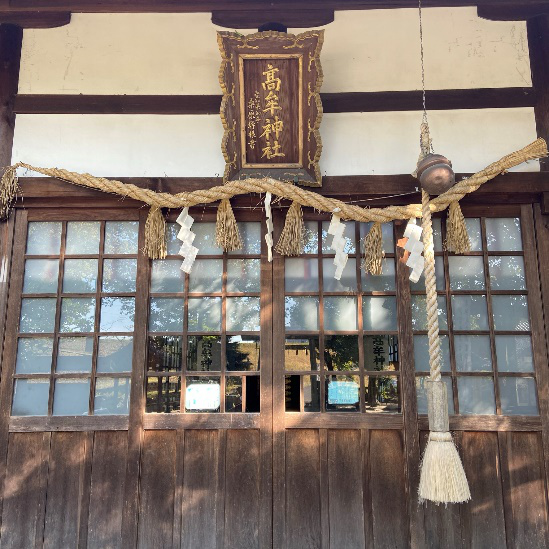
(Moriyama, Nagoya)
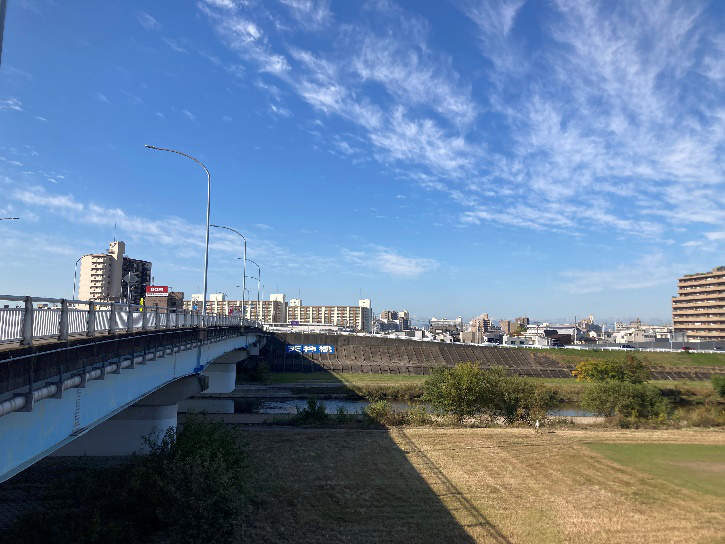
When the villagers heard the story, they went to the pawnbroker and tried to persuade him to give it back to them, but they could not reach an agreement, and finally, after a court case, the shrine and the pawnbroker came to an agreement that they would own it every six months.
The pawnshop was located south of the Yada River, and the bridge over the river near the sake brewery was named Tenjinbashi (Tenjin*4 Bridge) because the villagers carrying the Michizane image crossed it every six months.
"This is an anecdote that shows how important Michizane was to the local people.
Note 4: “Tenjin” is the name that deifies Michizane Sugawara after his death, or a shrine that enshrines the deified Michizane.
“Azuma-ryu” Today
Based on the sake grading system that used to exist until 1992, “Azuma-ryu” had a several gradings named as “Azuma-ryu Special”, “Azuma-ryu 1st”, and “Azuma-ryu 2nd”. However, with the change of the times, the grading system was abolished, and Ginjo and Daiginjo Sake became more popular. Then, sake lovers began to claim that it is difficult to distinguish them under the same brand name.
Therefore, Toshun Sake Brewery decided “Azuma-ryu” as a crown brand name, and created sub-brand names as “玲瓏(rei-ro)”, “龍の舞(ryu-no-mai)for the Ginjo-shu, and “龍田屋(Tatsuta-ya), original name of the company, “佐藤東兵衛(sato tohbei)”, “龍瑞(ryo-zui)” for the Jummai-shu.
All the brands have successfully inherited the history of the brewery by embedding the letters of “龍” and “東” in each name.
About Toshun Brewery
Established in 1865.
The founder of the company was Tohbei Sato. The second generation was Tohichiro, and while the first two generations had the "Toh (Higashi meaning east)” in their names, the third and subsequent generations did not have it in their names. The current Mr. Yukihiko Sato is the sixth generation.
The building materials of the brewery were purchased from the wood sold at the timing of rebuilding the turrets of Nagoya Castle. The original name of the brewery was "Tatsutaya", and it was incorporated in 1948.
The "Toshun" in the company name however is not related to the "Higashi" in "Azuma-ryu”. It was derived from the company's address at the time of its founding, Higashi-kasugai-gun, Aichi Prefecture (current Moriyama-ku, Nagoya City). The brewery took the first two Kanji of Higashi-kasugai, which reads as “To-shun”. It seemed to have been a coincidence.
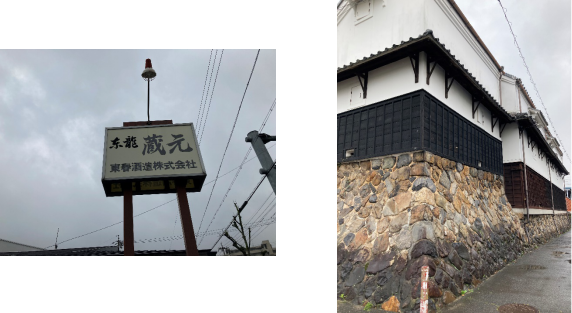
About the Typeface of "Azuma-ryu”
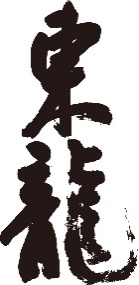
The current typeface of "Azuma-ryu" was created by calligrapher Tosen Mitsukuchi, who was a classmate of Nobuko Sato, the wife of the fifth.
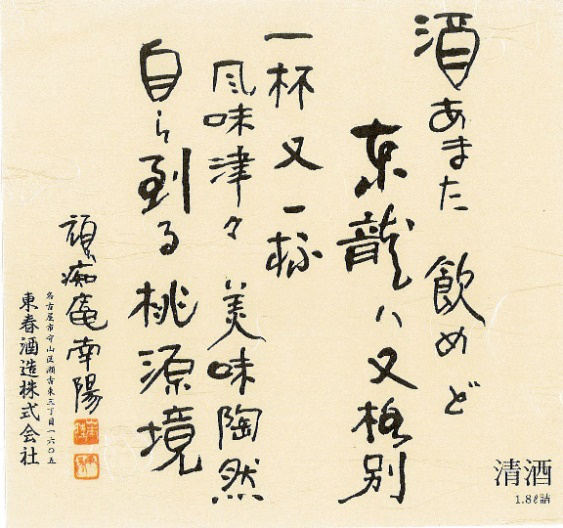
The label of the Junmai Daiginjo was designed by Nanyo Yamamoto, a calligrapher and mentor of the fifth generation.
Interviewee cooperated by: Mr. Yukinori Sato, President of Toshun Brewery
Interview date: May 19, 2021
Image data presented by: Presented by Toshun Brewery
Post Interview: The interview took place in an old sake brewery at the head office of Toshun Brewery (Moriyama Ward, Nagoya City). Surrounded by old sake brewing tools that reminded us of the history of the brewery, I listened to Mr. Sato's story and felt tense in the atmosphere.After the interview, Mr. Sato took me to the stone wall behind the sake brewery, which he used to play on in his childhood. I was deeply moved to see the stone wall that has seen the history of the sake brewery and will continue to see it in the future.

